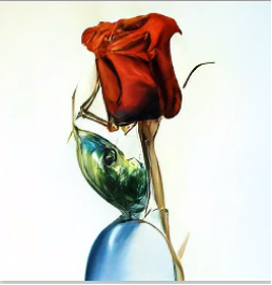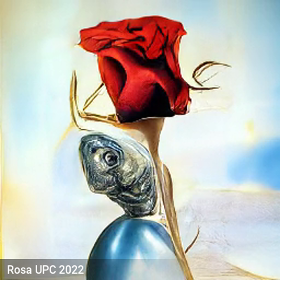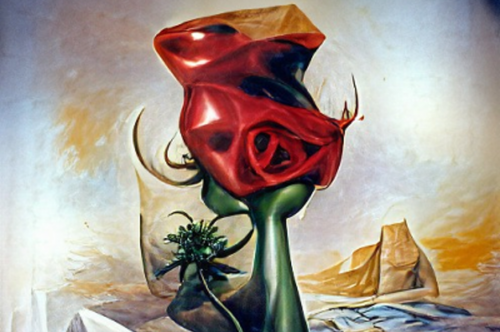Artificial intelligence (AI) and computer science applied to art make it possible to generate an image with deep learning generative models. With this technology, the UPC offers, this Sant Jordi 2022, the possibility of choosing a rose, or generating one of your own, based on the style of more than 180 artists, from Albert Ràfols Casamada to Zada Hadid, as well as Frida Kahlo, Vincent Van Gogh, Joan Brossa and Lola Anglada. The initiative, called ‘Roses UPC’ allows, in addition to choosing the artistic style by authors, to apply some distinctive features based on any type of concept or descriptor that one wishes to introduce.
On 21 April, on the occasion of Saint George’s Day, the Universitat Politècnica de Catalunya – BarcelonaTech (UPC) offers, with the initiative ‘Roses UPC’, the possibility of creating, sharing and sending the image of a unique and artistic rose, formed from deep learning generative models, based on neural networks and capable of producing an image from a text.
Each unique model starts from the image of an initial rose, which is modified by an algorithm that uses intensive computation and a series of complex calculations that occur at high speed to create a new rose. According to the chosen artist’s style, the final rose is generated from terms or concepts that can be introduced into the description to personalise it.
Once generated, the final rose is sent as an attached file to the e-mail address of the person who creates it, together with a link to send it, share it and write the dedication to the person to whom it is addressed. It also allows you to visualise, in a short video, how the algorithm has reinterpreted the initial rose.
Each rose created becomes part of the Roses UPC 2022 gallery, which can be shared via link, WhatsApp or Twitter, as well as downloaded and distributed freely, without commercial use, under the Creative Commons CC BY-NC-ND 4.0 license.
Intensive computing and neural networks
Building images with this technology requires intensive computation and the use of graphics processing units (GPUs), which are responsible for performing complex calculations at high speed. These resources are expensive and therefore the capacity to generate roses is limited to the current demand.
Internally, two neural network models are used: one is capable of generating the images, while the other judges the extent to which an image matches the artistic style and terms entered in the application form. This interaction guides the generator to produce more accurate images.
A Dalinian example
If you want to generate, for example, a Dalinian rose, you can select a rose in the style of Salvador Dalí and add the terms surrealism and beautiful to the description. The result will be a Dalinian digital rose, but with personalised features.
The system has, on the one hand, a text describing the image as ‘a red rose’ and, on the other hand, a text indicating what we want it to resemble, in this case the artistic style of Salvador Dalí and that it has distinctive features inspired by the terms ‘surrealism and pretty’ introduced in the description.
In the first iteration, the generative deep learning model will give the following probabilities to the image description:
- ‘A red rose’: 100%
- ‘Beautiful Surrealism by Salvador Dalí’: 0.5%

The algorithm will modify the image in such a way that the probabilities that the image obtained corresponds to the two sentences are as high as possible. For example, after several iterations (iterations in computationally intensive processes), the probabilities could be distributed as follows:
- ‘A red rose’: 95 %
- ‘Beautiful surrealism by Salvador Dalí’: 12 %.



In the images above you can see the evolution of the Dalinian rose, which can also be seen in this video on the generation process (link to the video).
Origin of the ‘UPC Roses
The ‘UPC Roses’ have been generated from the work of Katherine Crowson (https://github.com/crowsonkb) and the original author of the VQGAN+CLIP method (https://twitter.com/advadnoun).
The initiative, promoted by the UPCArts cultural programme, has been developed by InLab FIB, with the support of the Communication Service of the UPC.
InLab FIB is the innovation and research laboratory of the Faculty of Informatics of Barcelona (FIB) of the UPC. It specialises in the development of multidisciplinary R+D+i projects in the field of information technologies, both for public and private entities.
UPCArts is a programme of cultural activities for the entire UPC community that builds bridges and alliances between science and technology with art and culture. #RosaUPC22 helps to bring the artistic and technological gaze closer together.
Studies related to computer science and artificial intelligence
The UPC offers some degree courses in various fields of technology that make a project like Roses UPC possible, such as the degree in Computer Engineering, the degree in Artificial Intelligence and the degree in Data Science and Engineering.
